Related Research Articles

The Ash Wednesday bushfires, known in South Australia as Ash Wednesday II, were a series of bushfires that occurred in south-eastern Australia on 16 February 1983, which was Ash Wednesday. Within twelve hours, more than 180 fires fanned by winds of up to 110 km/h (68 mph) caused widespread destruction across the states of Victoria and South Australia. Years of severe drought and extreme weather combined to create one of Australia's worst fire days in a century. The fires became the deadliest bushfire in Australian history until the Black Saturday bushfires in 2009.
The Linton Bushfire was a wildfire that burned through private land and state forests near the township of Linton, Victoria, Australia on 2 December 1998. Firefighters from the Victorian state government's Department of Natural Resources and Environment and the Country Fire Authority (CFA) were deployed to put out the fire. At approximately 8.45pm, two firefighting appliances and their crews were entrapped and engulfed in fire following an unexpected wind change. The bushfire covered a maximum land of 660 hectares of private and public land.
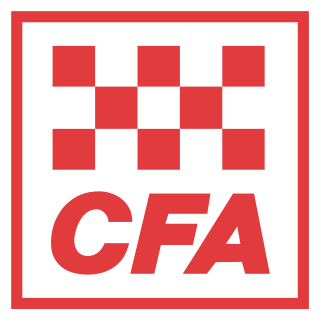
The Country Fire Authority (CFA) is a volunteer fire service responsible for fire suppression, rescues, and response to other accidents and hazards across most of the state Victoria, Australia. CFA comprises over 1,200 brigades organised in 21 districts, and shares responsibility for fire services with Fire Rescue Victoria, which employs full-time paid firefighters in major urban areas; and Forest Fire Management Victoria (FFMV), which manages fire prevention and suppression on Victoria's public lands. CFA operations and equipment are partly funded by the Victorian Government through its Fire Services Levy, and supplemented by individual brigades' fundraising for vehicles and equipment.

Christine Nixon APM is an Australian former police officer who was the chief commissioner of Victoria Police from 23 April 2001 to 27 February 2009, being the first female chief commissioner in any Australian state police force. After leaving Victoria Police, she was appointed as chair of the Victorian Bushfire Reconstruction and Recovery Authority in February 2009 until she stood down from the position in July 2010.

The New South Wales Rural Fire Service is a volunteer-based firefighting agency and statutory body of the Government of New South Wales.

The Department of Fire and Emergency Services (DFES) is a government department that is responsible for fire and emergency services in Western Australia. The department came into being in 2012 as a result of the Perth Hills Bush Fire review.
DFES is responsible for the management, training and funding of career and volunteer Services including:
Philip Christian Koperberg, is the Chairman of the New South Wales Emergency Management Committee, responsible for advising the New South Wales government on emergency response strategies, since 2011.

The Queensland Fire and Emergency Services (QFES) is the primary provider of fire and emergency services in Queensland. The QFES was established in 2013 to improve the coordination and planning of emergency services, adopting an "all hazards" approach to emergency management.
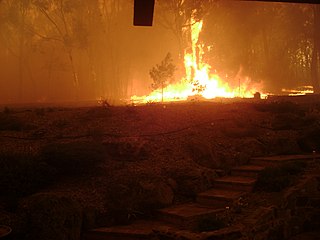
The state of Victoria in Australia has had a long history of catastrophic bushfires, the most deadly of these, the Black Saturday bushfires of 2009 claiming 173 lives. Legislation, planning, management and suppression are the responsibilities of the Victorian State Government through its departments and agencies including the Country Fire Authority (CFA) and the Department of Environment, Land, Water and Planning (DELWP).

Bushfires in Australia are a widespread and regular occurrence that have contributed significantly to shaping the nature of the continent over millions of years. Eastern Australia is one of the most fire-prone regions of the world, and its predominant eucalyptus forests have evolved to thrive on the phenomenon of bushfire. However the fires can cause significant property damage and loss of both human and animal life. Bushfires have killed approximately 800 people in Australia since 1851, and billions of animals.

The Black Saturday bushfires were a series of bushfires that either ignited or were already burning across the Australian state of Victoria on and around Saturday, 7 February 2009, and were among Australia's all-time worst bushfire disasters. The fires occurred during extreme bushfire weather conditions and resulted in Australia's highest-ever loss of human life from a bushfire, with 173 fatalities. Many people were left homeless as a result.

The Black Saturday bushfires were a series of fires that ignited across the Australian state of Victoria during extreme weather conditions on 7 February 2009. Burning around 450,000 ha for over a month, the fires destroyed over 2,100 homes, destroyed several regional towns and were fought by over 5,000 firefighting personnel. The Fires devastated many.
The 2009 Victorian Bushfires Royal Commission is an Australian Royal Commission that concluded on 31 July 2010. It investigated the nature of circumstances surrounding the Black Saturday bushfires.

The Newham Fire Brigade is a volunteer firefighting service located in Newham, Victoria at 1293 Rochford Road. The brigade is often referred to as the Newham CFA and was formerly known as the Newham Rural Fire Brigade. The brigade is part of the Mount Macedon Group in the Lodden-Mallee Region of the Country Fire Authority. Newham is located in the Macedon Ranges, which is one of Victoria's popular holiday spots and has a risk of bushfire during the summer months.
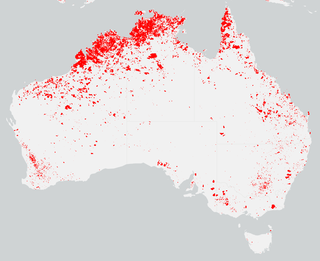
The summer of 2013–14 was at the time, the most destructive bushfire season in terms of property loss since the 2008–09 Australian bushfire season, with the loss of 371 houses and several hundred non-residential buildings as a result of wild fires between 1 June 2015 and 31 May 2016. The season also suffered 4 fatalities; 2 died in New South Wales, 1 in Western Australia and 1 in Victoria. One death was as a direct result of fire, 2 died due to unrelated health complications while fighting fires on their property, and a pilot contracted by the NSW Rural Fire Service died during an accident.

Emergency Management Victoria (EMV) is a state government statutory authority responsible for leading emergency management in Victoria, Australia by working with communities, government, agencies and business to strengthen their capacity to withstand, plan for, respond to and recover from emergencies.

Fire Rescue Victoria (FRV) is a fire and rescue service in the state of Victoria in Australia that serves the capital Melbourne and major regional centres throughout Victoria. FRV operates 85 fire stations with full-time staff firefighters, around half of which are in the Melbourne metropolitan area, and the remainder in regional cities and large towns throughout the state. 34 of these stations which are classified as peri-urban and regional stations, are co-located with volunteer brigades of the Country Fire Authority (CFA).
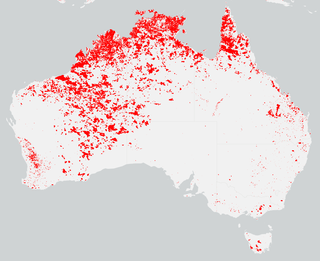
The bushfires were predicted to be "fairly bleak" in parts of Australia, particularly in the east, by the Bushfire and Natural Hazards Cooperative Research Centre (CRC) chief executive, Richard Thornton, in September 2018. Large bushfires had already burned through southern New South Wales during winter. The outlook for spring was of a higher likelihood of fires with a twice the normal chance of an El Nino for summer. Many parts of eastern Australia including Queensland, New South Wales and Gippsland, in Victoria, were already in drought. Above normal fire was also predicted for large parts of Southern Australia and Eastern Australia by the Bushfire and Natural Hazards CRC. The forecast noted that Queensland had recorded the ninth driest and fourth hottest period on record from April to November. New South Wales recorded the fourth hottest period and eighth driest on record, while Victoria experiences the 13th driest and seventh hottest period on record. Authorities in New South Wales brought forward the start of the bushfire season for much of the state from October 2018 to the beginning of August 2018.
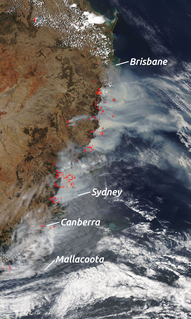
The 2019–20 Australian bushfire season, colloquially known as the Black Summer, was a period of unusually intense bushfires throughout Australia.
The Royal Commission into National Natural Disaster Arrangements, also referred to as the Bushfires Royal Commission, is a royal commission established in 2020 by the Australian government pursuant to the Royal Commissions Act 1902 to inquire into and report upon natural disaster management coordination as it related to the 2019–20 Australian bushfire season. The Commission is charged with the responsibility to examine the coordination, preparedness for - including hazard reduction burns - response to and recovery from disasters as well as improving resilience and adapting to changing climatic conditions and mitigating the impact of natural disasters. The establishment of the Royal Commission followed a constitutional grey zone by directly initiating defence force deployments, utilising a call out of the Australian Army Reserve, with Australian Defence Force personnel serving in support of state and territory response efforts, without clear rules for engagement. The commission is due to complete its report by 31 August 2020.
References
- ↑ "Victoria appoints emergency management commissioner". The Weekly Times. 1 May 2014.
- ↑ "New role for former Bendigo firefighter". Bendigo Advertiser . 1 May 2014.
- ↑ "The Commissioner". Emergency Management Victoria . n.d. Archived from the original on 5 January 2016. Retrieved 27 December 2015.
- ↑ Merlino, James (Deputy Premier of Victoria); Lapsley, Craig (7 August 2018). "Statements from the Deputy Premier and Craig Lapsley". Emergency Management Victoria (Press release). Archived from the original on 7 August 2018. Retrieved 14 August 2020.
- ↑ Bushfire & Natural Hazards CRC, Craig Lapsley
| Public service appointments | ||
|---|---|---|
| New title | Emergency Management Commissioner, Emergency Management Victoria 2014 – 2018 | Succeeded by Andrew Crisp |
| Fire appointments | ||
| New title | Fire Services Commissioner 2010 – 2014 | Position abolished |